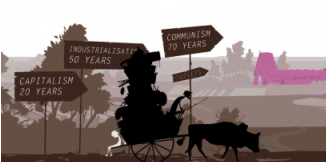 "Poor Us" examines the changing world of poverty. "Poor Us" examines the changing world of poverty. Tags: capitalism, class, globalization, historical sociology, inequality, methodology/statistics, political/economy, absolute poverty, antônio conselheiro, charity, colonialism, comparative historical analysis, industrial revolution, poorhouse, relative poverty, social history, welfare state, workhouse, 21 to 60 mins Year: 2013 Length: 58:05 Access: YouTube Summary: This exquisitely animated documentary tells a sweeping social history of world poverty. You, the viewer, are the protagonist in this film floating through the meandering jet stream of world history. "If we want to make poverty history," the narrator explains, "then first, we need to understand the history of poverty." ● The documentary appropriately begins in prehistory (2:35), and in a more or less linear fashion, moves through humanity's early large scale civilizations, including ancient Egypt (4:40) and ancient Greece (5:40). Zipping forward to the Middle Ages, the story unfolds again in Cairo (8:20), and then lingers in Paris of the same period (10:50). The history of colonialism is woven into the story with a look at the Spanish conquest of the Inca Empire (14:20), the Portuguese conquest of West Africa (16:20 and 34:40), and British colonial rule in India (36:00). Poverty in a neocolonial context is later examined in Ghana (38:50 and 43:55), and China makes appearances as the site of both model relief efforts and tragic famine (18:30 and 43:20). At the 20:30 mark the story returns to Western Europe in order to consider the impact of the Industrial Revolution on poverty, and then moves toward a conclusion which contemplates the changes wrought by globalization. ● While this 58-minute film understandably fails to deliver a truly exhaustive account of the the world-historical processes associated with poverty, the film would be an excellent tool for illustrating comparative historical analysis in sociology. Systematic comparison is of course central to comparative historical work, and this film succeeds in illustrating the importance of comparison by briefly drawing on eighteenth century China as a rare instance where prosperity for some didn't necessarily come at the cost of desperate poverty for others. What does the film's analysis of poverty gain by including this "negative" case in the story? One answer is that the case of China complicates the viewer's understanding of poverty by exposing its causes as far less determined and far more contingent. Submitted By: Lester Andrist
2 Comments
Manuel Franco
7/29/2023 03:02:03 am
I just want to say Thank You to everyone who supported me through the years. My name is Manuel Franco, New Berlin, Wisconsin. My story of how I won the Powerball lottery of $768.4M is a bit of a tale. I have been playing Powerball tickets for 6 years now since I turned 18. I bought my first ticket on my 18 birthday. I was feeling very lucky that day because I had contacted Dr. Odunga Michael to help me with the winning Powerball numbers. I really had that great great feeling that I looked at the camera wanting to wink at it. I only did a tiny part of it and trusted him. He gave me the numbers after I played a couple other tickets along with it for $10. I checked my ticket after the winnings came online and saw the numbers were correct including the Power play. I screamed for about 10 minutes because it felt like a dream. I had won $768.4M. You can check my winning testimony with the lottery officials just with my name search. Thank you Dr Odunga. Well, his email is [email protected] and you can also call or Whats-app him at +2348167159012 so you guys can contact him
Reply
mark hold
7/8/2024 12:34:11 am
Herbal Penis Enlargement product is 100% guaranteed to Enlarge and get a better ERECTION, the reason why most people are finding it difficult to enlarge Penis is that they believe in medical reports, drugs and medical treatment which is not helpful for Penis Enlargement. Natural roots/herbs are the best remedies which can easily Enlarge your Penis permanently Contact Dr MOSES BUBA via Email: [email protected] or via WhatsApp: +2349060529305. for Natural root and herbal remedies put together to help Enlarge manhood and Erect healthily. I also learn that Dr MOSES BUBA also can cure other types of diseases, HEPATITIS B,DIABETICS,CANCER,HPV,LOW SPERM CAM, HIV/STDS, FIBROSIS LOST OF WEIGHT, BREAST ENLARGEMENT, HIPS and BUMS ENLARGEMENT etc .
Reply
Leave a Reply. |
Tags
All
.
Got any videos?
Are you finding useful videos for your classes? Do you have good videos you use in your own classes? Please consider submitting your videos here and helping us build our database!
|
 RSS Feed
RSS Feed
